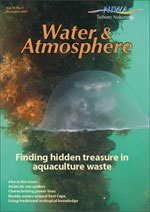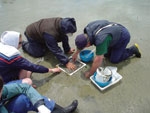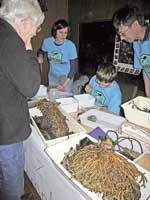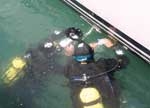PDF of this article (206 KB)





Marine Bioblitz finds new species
NIWA marine biodiversity scientists played a major role in the world’s first Marine Bioblitz, held on Wellington’s south coast in the proposed Kupe/Kevin Smith Marine Reserve. Held during October, the blitz recorded over 550 species, including five that are new to science.
One of these, a graceful anemone with 32 tentacles, was found by NIWA scientist Malcolm Francis during a night dive. “We were swimming around with torches, and I wanted to take a look over the sand, because we often neglect sand as a habitat,” says Malcolm, an expert underwater photographer. He spotted several of the anemones as they emerged from their sand burrows, and quickly photographed them. They are 5 to 10 cm long, pale, and sand-coloured, with delicate spots on their tentacles. Subsequent examination revealed that the organism is a tube anemone, or cerianthid. “I’ve discovered new fish species before, but it was a big thrill to find this elegant creature,” says Malcolm.
Other new species discovered during Bioblitz were a bryozoan (a tiny animal that builds a stony skeleton), a diatom (a single-celled phytoplankton), a tiny red and green nudibranch (sea slug), and a scarlet flatworm that represents a group (Acoela) with no named species in New Zealand.
The Marine Bioblitz was a big success, not only in finding a huge number of species, but also in getting lots of Wellingtonians involved with their coastal environment. Guided kayaking, rock-pool hunts, walks, beach clean-ups, and public talks were all part of the monthlong programme.
“The whole event was terrific,” was the opinion of Shane Ahyong, one of the NIWA team which spent each Bioblitz weekend identifying and cataloguing species, and talking to the public. “There was lots of interaction between the public and the scientists, and it was great to see how people react when they’re shown things they’ve never seen before. It was surprising that we found so many species over just four weekends. But we know that there are still many more species out there. We’re already making plans for a second Bioblitz, once we’ve all recovered from this one!”
The Marine Bioblitz was supported by a host of organisations and local businesses, and the NIWA team was led by Wendy Nelson.
For further information, contact: Dr Wendy Nelson, 0-4-386 0600, [email protected] Heather Anderson, 0-4-801 2218, [email protected] or visit the website: www.marinebioblitz.wellington.net.nz
Taking border patrol one step further
The spread of non-indigenous marine species through New Zealand’s coastal ecosystems is an ongoing concern. There are several mechanisms by which non-indigenous organisms are spread domestically; however, marine shipping is the single most important way these species get to New Zealand in the first place.
Since 2004, NIWA has been involved in a project for MAF Biosecurity New Zealand (BNZ) that assesses the quantity and diversity of non-indigenous species transported to New Zealand as ‘fouling assemblages’ on the hulls of vessels arriving from overseas. The research is being carried out by several providers, each addressing a different type of vessel (for example, merchant, passenger, fishing, recreational).
NIWA has two roles in the overall project. First, we’re examining the types of organisms brought to New Zealand on the hulls of private yachts. Then, during the final stage of the research, we’re analysing the data collected by NIWA and other providers and developing statistical models that quantify the relative threat to New Zealand’s marine biosecurity of different vessels. This is the first project worldwide to compare comprehensively the relative importance of all vessel types in introducing nonindigenous species.
Sampling has been completed and all biological specimens have been examined and identified by expert taxonomists. Hundreds of species from more than a dozen marine phyla have been collected from approximately 500 vessel hulls, and it has become apparent that some areas of a ship hull are more likely to harbour fouling species than others. Unfortunately, ‘niche areas’ like rudder and propeller shafts, recesses in the hull, the keel bottom, and other hard-to-get-to places are particularly popular with marine organisms, including non-indigenous species.
This research, which concludes in the middle of next year, will help BNZ understand the rate of influx of nonindigenous species into New Zealand via vessel fouling and provide a framework to prioritise management efforts toward higher-risk vessel types. We hope to get New Zealand one step closer to a predictive tool for identifying high-risk vessels – based on their maintenance and travel history – before they enter the country.
For further information, contact: Dr Oliver Floerl, 0-3-343 8056, [email protected]
